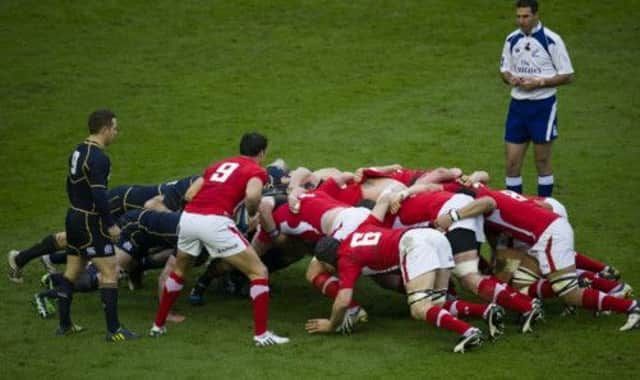Scrum law change could prove to be revolutionary


The beast 6ft 4in props being dropped by coaches as of no use? Back rows moving into the front because their handling skills are more relevant than being able to take a thundering ton ‘hit’? Hookers actually hooking, and scrum-halves putting the ball into scrums straight? And, mercy me, an end to the turgid scrum re-sets that have plagued the game in recent seasons?
It doesn’t stop there. Coaches from Hawick YM to the All Blacks’ Steve Hansen believe it will lead to more attacks off scrums actually going somewhere, players running into space and the game flowing at a more rhythmic pace than the stop-start boredom of recent years.
Advertisement
Hide AdAdvertisement
Hide AdThat is the hope for the new IRB directive for the scrum. Driven by the campaign for safer rugby, there will be no ‘hit’ allowed so gone are the ‘crouch-touch-pause-engage’ and ‘crouch-touch-set’ commands, and hello to ‘crouch-bind-set’.
On crouch the packs bind up, on bind they step in close, almost ears to ears rather than foreheads to foreheads, and on set they engage. However, only on the entry of the ball from the scrum-half are they allowed to start pushing. Referees have been told to penalise teams who push before the ball is in. No re-set, no warning, but immediate free-kick or, if continued, penalty. Zero tolerance.
No ton packs crashing into each other and straight to ground is the great hope. In truth, club rugby did not have a huge problem with scrums. It was when it stepped up to pro and international levels that they frequently crashed to earth and clocks timed the waste of a rugby match.
However, the change should still benefit all levels. In the southern hemisphere games under the new law scrum-halves have been forced to put the ball straight in to the front row, instead of in to the second row, and scraps for the ball have returned. It was comical initially watching some of the best hookers in the world baffled by the science of how to use their foot to hook it back, having spent the past decade acting as a third prop at scrum-time, not to mention Kiwi, Wallaby, Bok and Argentine scrum-halves looking bewildered as refs repeated ‘no, when I say straight, I mean in a straight line’.
Hansen believes it will not only improve attacking rugby but also retain the scrum as a fundamental part of the union game.
“You’re going to get rewarded for scrummaging well,” he said. “We’re excited by the prospect of what it’s going to bring.
“We said there’d be some teething problems but the great thing about it [against Australia], I thought, was we didn’t have too many collapses did we, so once we iron out the whole thing, and get used to it, I think it’ll be great for the game.”
Training parks have been buzzing this summer from Lenzie to Leicester, Melrose to Montpellier and Currie to Cape Town on the implications of the change. The Rugby Championship has been the first trial ground and, after early problems, scrums stayed up and counter-attacking rugby lit up the Tests.
Advertisement
Hide AdAdvertisement
Hide AdFour of a total 17 turnovers won by New Zealand – many from scrums – led to tries as the Kiwis continued their tradition of being first to exploit the benefits of change. The club game may not boast All Blacks skills, but after a generation dominated by bigger men, wall-like defences and bitter stifling of attacking rugby, there is a fresh hope around today’s kick-off.
To give it a chance, firstly, referees must be strict, consistent and clear – arm signals help us spectators – and assistant referees play their part, notably in penalising encroachers eating space behind the scrum and ruck back-foot.
Secondly, players and coaches have to embrace it.
When the southern hemisphere nations agreed to bring in a new approach to improving the entertainment of the game – the Super Rugby teams were told they had to, admittedly, or lose the TV money – which was to shun cynical killing of ball at rucks when opponents attacked their 22, there was a flurry of penalties, yellow and red cards. Referees had been told to police it strictly and they did, and after a couple of weeks of madness it settled.
How long it takes to settle here, and for games to flow, depends on the intelligence and ambition of our players and coaches.
They will, and should find ways to turn the changes to best suit their players and teams, but those that continue to rattle up penalties and lose players to yellow cards will be those failing to do so cleverly, ie; within the laws.
Rugby has needed this change and the responsibility now lies with those at the sharp end to make it work. Game on!